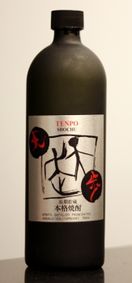Shochu: Difference between revisions
Uncle Jesse (talk | contribs) (Adding image) |
Uncle Jesse (talk | contribs) No edit summary |
||
| Line 1: | Line 1: | ||
[[file:shochu.jpg|thumb| | [[file:shochu.jpg|thumb|132px|right:Shochu]] | ||
Shōchū ("burned liquor") is a [[Distillation|distilled]] [[Alcoholic_beverage|alcoholic beverage]] which is traditionally produced in Japan. | Shōchū ("burned liquor") is a [[Distillation|distilled]] [[Alcoholic_beverage|alcoholic beverage]] which is traditionally produced in Japan. | ||
Revision as of 00:11, 15 September 2017
Shōchū ("burned liquor") is a distilled alcoholic beverage which is traditionally produced in Japan.
Shochu can be made from rice, although it is more commonly made from barley, potato or sugar cane. Most shochu is around 25% alcohol by volume, although some varieties (particularly Okinawan awamori) can go as high as 43%.
Shochu should not be confused with sake, a brewed (not distilled) rice wine. However, in Southern Kyushu sake actually means potato shochu, imo-jochu; while in Okinawa it means the local brew awamori (泡盛, lit. "bubble top") and kūsū (aged awamori, lit. "old liquor"). Awamori, while also a distilled rice wine, differs from normal shochu as it is made from long-grained Indica rice, not the short-grained Japonica usually eaten in Japan.
Shochu made from mixed ingredients are often used to make mixed drinks called chūhai (short for "shōchū highball")
In Korea, shochu is known as soju.
